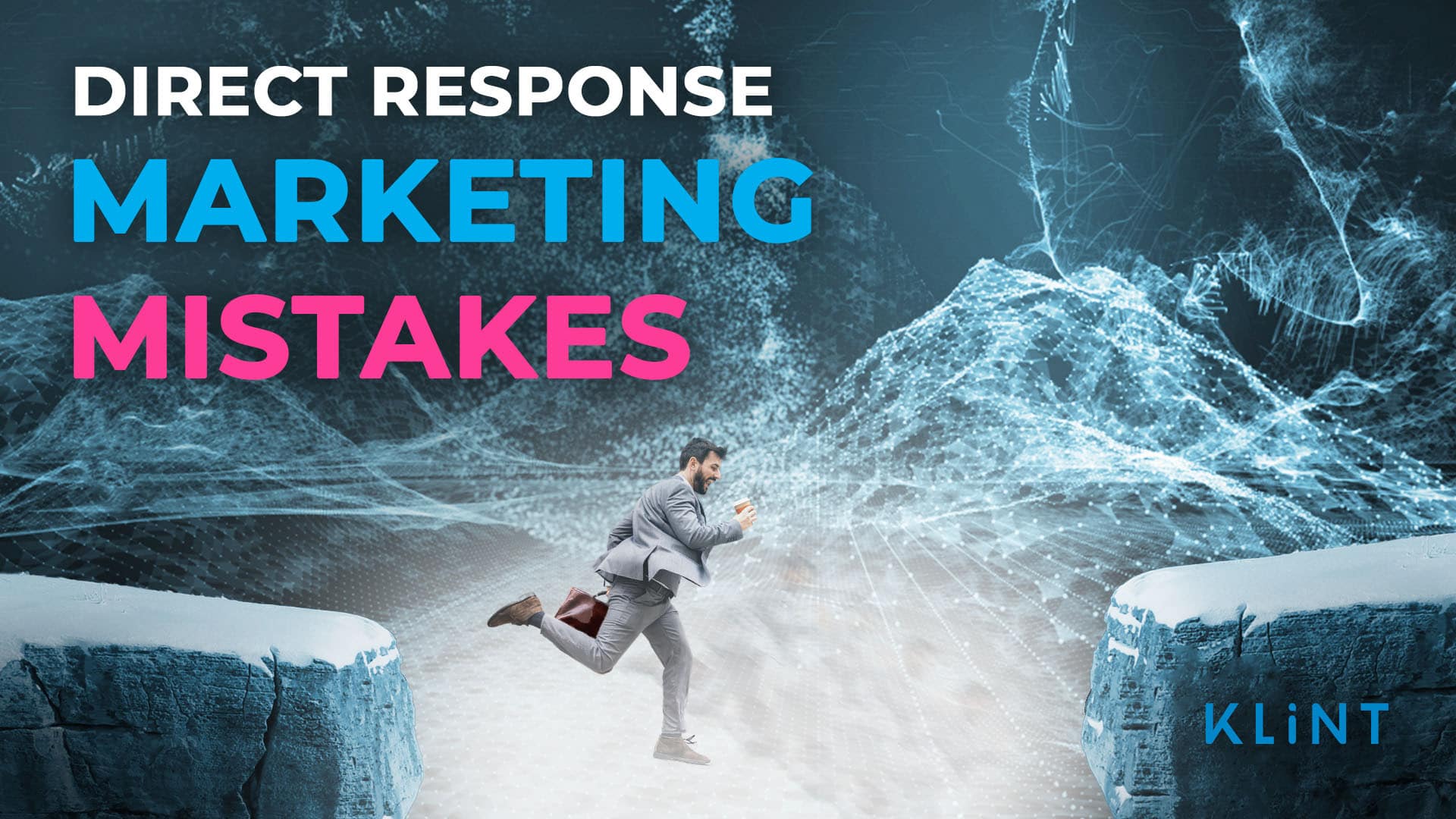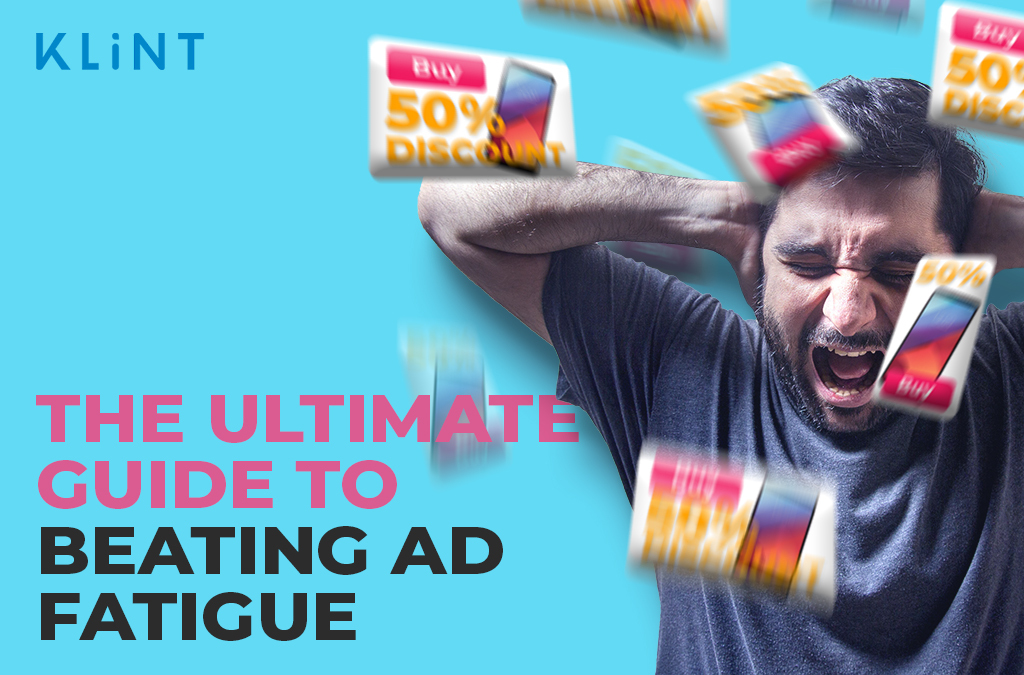This blog will cover everything you need to know about direct response marketing: the good, the bad and the ugly.
We’ve collected the most common mistakes we see businesses make over and over again that we want to share with you. Better yet, we’ll tell you how to avoid them.
Whether you’re a complete beginner to direct response marketing, or you have extensive experience, you’ve come to the right place.
In this blog, we’ll share some of the industry secrets we’ve learned through being a frontrunner growth hacking agency for the past 3 years, and we’ll also share some excellent direct response marketing examples.
Let’s start with the basics – what is direct response marketing?
Table of Contents
What is Direct Response Marketing?
We’ve all interacted with them at one time or another.
Direct response marketing is the reason you’re a subscriber to dozens of newsletters you never read, and it’s also why you make most of your impulse purchases.
It’s a popular marketing tool, used primarily to get a direct response or instant action from customers, hence the name!
Direct response marketing, also referred to as DRM, is a tried and tested way to drive conversions and increase sales. It’s a strategy designed to propel a particular desired action, such as buy, sign up, order, follow or visit – NOW.
But, your direct response marketing campaign won’t get results if it’s not done right. It has to persuade your target audience and move them to an action to drive conversions.
This approach is good in the sense that no matter how small or unknown your brand is, you can get amazing results with direct response marketing. That is if you know your audience’s pain points, have a working solution and are able and willing to master the best practices.
It is a data-driven tool because while it measures how many people respond to your campaign and measures your click-through rate and conversions, it also tracks your immediate return on investment. Since it has one unique desired action, ROI is easily calculated.

Direct response marketing campaigns come in various shapes and sizes. Ad campaigns, social media campaigns, direct response websites, landing pages, referral campaigns, newsletters, videos, billboards are just a few of the different mediums.
Direct response websites are organized in a way that visitors (hopefully) convert when on your site, rather than just getting information.
Direct response commercials are the ones that make people act on them, rather than just make people aware of your product or service.
Intriguing direct response copywriting is essential to a successful campaign, and it’s also important to include an attention-seeking headline and a compelling call to action. We’ll cover this in greater depth later in this blog.
Good direct response marketing campaigns are targeted to a well-specified audience and only have one specific goal. The goals all depend on your business, industry and interests, but might be anything from direct purchases to a follow on social media.
Those who convert due to direct response marketing, even though they don’t buy anything, are extremely valuable contacts as you’ve established the basis of personal communication that will prove invaluable for your sales team. No need to spend more time on cold leads!
Still not convinced? Let us tell you more.
Why is Direct Response Marketing so effective?
The simplicity of direct response marketing is key to its effectiveness. With that, we don’t mean it’s so easy to get it right, but for the potential customer, it’s simple to interact with.
The key to this is the call to action (CTA) of the direct response copy, which is where you tell the customer what to do, with such urgency, excitement and ease that they’re compelled to act.
Join now, signup today, and subscribe are just a few examples of CTAs.
Another critical aspect of the effectiveness of direct response marketing is that, because it only has one goal, the results are very black and white. You eliminate costly guesswork because you know immediately if your campaign is generating conversions or not.
These results give the marketing team insight into what works, and what doesn’t. What phrasing, imagery, and positioning work and what ultimately does not convert.
In order to maximize the effectiveness of your direct response marketing efforts, it’s important that the audience is targeted and that marketers are fearless in trying out different things and editing out those aspects that don’t convert.
Agility is a keyword for direct response marketing companies.
With this knowledge in hand, let’s take a look at the 10 of the worst mistakes we’ve seen in direct response marketing campaigns.
10 Direct Response Marketing Mistakes Most Businesses Make – and How to Avoid Them
It can be easy to make errors when you’re running a direct response campaign. Here are some of the worst mistakes that it’s essential to avoid.
Direct Response Marketing Mistake 1: Focus on branding
Direct response marketing is not about brand awareness. Although brand awareness is an important part of any business’s marketing strategy, direct response marketing usually does not contribute to it.
Direct response marketing focuses on what makes your potential clients take action today.
In your direct response marketing campaign, don’t talk about your brand, story, or founder (unless it’s very relevant).
Talk about the one thing you are solving for your audience when they follow, buy or sign up.
Direct Response Marketing Mistake 2: Not personalizing campaigns
For direct response marketing to work, it needs to directly address a specific audience you are trying to reach. Who are your ideal customers? Who benefits most from your product? It’s impossible to sell to everyone.
Speak directly to those who benefit most, in a way they can’t resist.
The strategy could look like this; your direct response marketing landing page is optimized for your biggest target audience, and then you run smaller direct response campaigns on social media or Google Ads that target different niche groups within your audience.
Customers want businesses to use data to personalize their experiences. Research shows that 91% of customers are more likely to shop with brands that provide relevant offers and recommendations.
If you haven’t already found out who your target audience is, take a look at people who’ve already purchased your product or service or look at your competitor’s audience.
Direct Response Marketing Mistake 3: Non-existing funnel
When you know who your target audience is, you need to understand how familiar they are with the problem you are solving.
Some don’t even know this is their problem yet. Others are sitting with their wallet in hand, ready to buy the solution.
Therefore, you will need to create different direct response copy aimed at each stage. This is what we call a customer sales funnel.
The stages of a customer journey are commonly these 5:
Customers at the first stage need short, attention grabbing content whereas customers at the third stage need more detailed information.
Direct Response Marketing Mistake 4: Spending too little time on the headline
A good headline is 80% of direct response copywriting. When you’ve nailed your headline, you are very far along on your mission. We recommend spending as much time on your headline as you do in crafting the rest of your text.
If the headline is not nicely formulated, all of your other content efforts are for nothing.
It’s smart to work with a template, collect headlines that work, learn from them and re-use what converts. You can use the below points as inspiration, your headline needs to accomplish at least one:
- Stimulate curiosity
- Provoke urgency
- Make a promise
- Highlight benefits
- Be Data-driven
Direct Response Marketing Mistake 5: Unclear CTA
It’s one thing to leverage the value proposition of your product, but all direct response campaigns need a clear call to action (CTA).
Potential customers need to know what to do after they’ve realized your product will benefit them. Therefore, a simple, clear, instructive and easy action is something you need to include in your direct response copy.
This looks like “Sign up now” or “Buy now”.
Direct Response Marketing Mistake 6: No deadline to the action
If you want people to act now on your direct response marketing content, you need to create urgency. People need to feel that they are missing out by not clicking on your offer right now.
Research shows that almost 70% of millennials (age 18-30) experience the fear of missing out (FOMO) and 60% of shoppers make purchases within 24 hours of experiencing FOMO.
Aim to create urgency either in exclusivity or timeframe. A limited-edition product is one direct response marketing example, an offer that ends in a few hours is another.
Direct Response Marketing Mistake 7: Vague direct response copy
Your direct response copy needs to focus directly on the pain points of your audience and outline exactly how you are going to help.
It’s a common misconception that because YOU know that your product is great, customers will immediately understand how incredible it is.
Some marketers are too vague and unfocused in their copywriting, even direct response copywriting where clarity and pointedness is the point.
It’s Klint’s experience that so-called power words like exclusive, instant, discover, complementary and opportunity are words that spark interest and urgency. You might feel they’re excessive, but sometimes that’s exactly what sells.
The magic happens when you exclude common phrases, don’t promise something you can’t deliver, and use forceful and strong language that drives action.
If you are a direct response copywriter, read on for a whole chapter about how to create direct response copywriting that converts.
Direct Response Marketing Mistake 8: Unidentified goal
Direct response marketing campaigns can have very different goals, depending on what you want to achieve. Just don’t make the mistake of having many or unclear goals when designing your campaign.
Not nearly all direct response marketing campaigns aim for direct sales. The goal can also be signups for a newsletter, sharing social media posts, signup for a free trial, clicking through to your webpage or other KPIs your business is trying to achieve.
Your direct response marketing campaign needs to be optimized for one specific desired action so you can measure its success.
Direct Response Marketing Mistake 9: Not testing your copywriting
Since your direct response copy is focused on one action, it’s very easy to try out your copywriting to see if it’s giving you the results you want.
Don’t be shy of testing everything to see what works best. Play around with different words, different actions, different positions, different phrasing, different tone of voice.
See what your audience engages with and continue from there. That’s what the direct response copywriting game is all about!
Direct Response Marketing Mistake 10: Selling the features, not the benefits
Many businesses sell their products by counting all the features their product has to offer, and sometimes that might work.
But instead of simply listing the features, focus on how it benefits the customer. The benefits might be time-saving, increased productivity, money-saving, higher social status and so on.
Like someone somewhere said to explain this „In 2001 when Steve Job introduced the iPod, he didn’t get on stage and say: The iPod. A 5GB MP3 player, that my team has been working really hard on. He said: The iPod. 1000 songs in your pocket”.
Direct Response Copywriting that Converts
It’s amazing the effect words can have on people. Words can make people fall in and out of love, change their minds, drive them to a certain action and start a war. Not any words, but the correctly crafted words.
Direct response copywriting is probably the most time consuming and vital part of your direct response marketing process.
A direct response copywriter has to have the courage to be persuasive, get creative and not be afraid to edit out what isn’t converting in the direct response marketing copy, even though they personally like it.
Successful Headlines
A direct response copywriter will have to spend a good deal of time on the direct response headline as that’s your only chance to get possible clients to read the rest of your direct response copy.
The headline needs to stimulate curiosity, make a promise, provoke urgency or highlight benefits. Depending on your audience it can be creative and fresh, or classic and straightforward. It can be a wordplay or have a punch, it can be two words and it can be ten.
But we can be sure that if the headline is bad, the rest of your direct response copywriting effort is all for nothing.
Compelling Copy
In direct response copywriting we need to keep in mind people’s limited attention span. Being a direct response copywriter is similar to standing in the streets asking “could I steal half a minute of your time?”
Except you’re not asking, but placing your shortest and most intriguing selling pitch in front of them.
As a direct response copywriter, it’s important to keep your buyer persona in mind when writing direct response copy. Speak directly to this person. If you have multiple diverse audiences, you need to segment and write different direct response copies aimed at each one.
Direct response copy has to be at the same time short, but the customer also has to have all the necessary information in order to make their decision.
We’ve mentioned pain points and the benefits before, and there’s a reason we’re doing so again. A direct response copywriter should be focusing on the why. Why should people be bothered to read on, why should they act on your direct response copy?
Are you making their life more insightful with your newsletter? Are you selling them a product that will save them time and money? Are they signing up for a free webinar that you host? Are getting funny GIFs from you on their Social Media feed? Saving time and money with your new automation software?
Persuasive direct response copy almost always includes powerful words that are proven to convince or grab people’s attention. Power words are easily found on Google, but are for example:
- Authentic
- Breathtaking
- Effortless
- Exclusive
- Fundamental
- Guaranteed
- Instantly
- No Risk
- Free

Urgent call to action
As a direct response copywriter, you also have to make sure you include the “Call To Action” (CTA), the what and the how. This is the key aspect of direct response marketing. What is it that you want the customers to do? And how do they do it?
Last but not least, don’t forget about the when. Customers tend to respond immediately to offers that have an expiration date or limited number. If they don’t do it now, they might miss out.
Humans are slaves to our emotions, and the fear of missing out is a strong motivator, particularly for millennials. As highlighted before, 60% of people make purchases because of FOMO, mostly within 24 hours. Words can create the fear of missing out, such as
- Ends soon
- Limited time
- Never Again
- Act Now
- Limited edition
In summary, successful direct response copywriting includes:
- A strong headline
- Power words
- A message about customer’s pain point and/or benefits
- A “Call To Action”
- A deadline
Let’s take a look at some great direct response marketing examples that created conversions:
5 Successful Direct Response Marketing Examples
We’ve talked about the most common mistakes in direct response marketing, let’s take a look at some direct response marketing examples that did not make the mistakes above and succeeded in their pursuits.
Share a Coke
A great example of direct response marketing with consumer focus is the Coca-Cola “Share a Coke” campaign.
The idea behind it was that the company simply wanted to make a campaign that brought it closer with its customers, and what better way to do this than by printing personal names on the bottles.
The call to action was to share a coca-cola with a certain person, friends, family, mama, papa and so forth, hence purchasing a bottle of Coca-Cola.
Personalization is one of the main components of direct response marketing and Coca-Cola was banking on the idea of seeing your own name, or of someone you wanted to share a Coca-cola on a bottle would encourage you to purchase.
The result? Coca-Cola’s organic web traffic increased by a staggering 870% with a 40% increase in Facebook page likes, plus 500.000 photos shared using the #ShareaCoke.
Those are incredible figures from simply adding some personal names to bottles. You could go to their Facebook page and order a bottle with your name on it, and thousands of people around the world thought this was a brilliant idea.
Harry’s referral program

Harry’s is a men’s grooming and shaving company that launched an excellent direct response marketing referral campaign that is widely known and serves as an example for all direct response marketing companies.
The call to action was to refer Harry’s products to a friend and the more of your friends converted, the more free products you earned.
You signed up via email, shared via social media and got free Harry’s products when a friend signed up. For each new friend, there was a prize and top referrers got one year of free blades.
Instead of complicated segmented campaigns to acquire new leads, they relied on word-of-mouth recommendations from current customers to accumulate warm new leads.
This resulted in skyrocketing customer satisfaction and thousands of new leads.
Salesmate’s cold email templates

This direct response ad is found on Salesmates’s website.
People browsing Salesmates are very likely interested in sales and might be tempted to try out these cold email templates that worked so well for Salesmates. You only have to give them your email address.
This is a great example of direct response marketing where the goal is not to sell, but they are building a list of potential customers already interested in sales and might engage with their sales-related content or even buy their product down the line.
Social Media advertising
People spend a tremendous amount of time on social media and ads usually fit naturally in with other content on the platforms.
Facebook, Instagram, TikTok, and Twitter all have a wide variety of data about their users, so the possibilities are endless in targeting specific audiences.
Plus, nearly a third of internet users go on social media to find new products, research says.
Good imagery is important in direct response marketing campaigns on social media, as these platforms are very visual, so make sure to make your content aesthetically pleasing.
The platforms often offer to store address and payment information for users which gives response marketing on social media the possibility of being highly effective. Purchases can be just 3 clicks away, so if your ad is compelling and well targeted the sky’s the limit for you.
As an example, this Hello Fresh Facebook ad has all the essential elements of a good direct response marketing ad in place; good visuals, attention-seeking headline, call to action and urgency.
Proactiv’s Infomercials
Proactiv was one of the most famous skincare brands in the US in the 90’.
Their fame came from their numerous direct response commercials on TV. The commercials showcased “before and after” photos, interviews with people who had used the products successfully and communicated the pain of bad skin.
They had a 60-day money-back guarantee and a number to call to order the product. If customers called while watching the infomercial, they got a free gift with their order.
Proactive made millions, some say mainly because of these direct response commercials.
Direct response commercials such as these ones are a perfect example of a successful campaign. They pointed attention to the pain points of customers, orders were risk-free, they had a strong CTA, and created urgency.
Make direct response part of your day-to-day operations
It is widely understood that direct response marketing is an event in the form of a campaign, rather than a practice, which is true for many marketing departments.
Although that is great, it is safe to recommend integrating direct response marketing into your day-to-day operations. Integrate the best practices in direct response copywriting and testing into every social media post, video, podcast and newsletter. Make your site among direct response websites in order to increase your conversions and ROI.
The goals of each direct response marketing technique can be subtle and small, but integrating DRM into day-to-day operations will give you the needed practice to perfect your own tone of voice, designed to give you the conversion rates you so desperately want.
Final thoughts
Direct response marketing is a result-oriented and data-driven tool that is proven to be the best tool to get people to act now.
Whether a blog post, ad, social media campaign, video, landing page or other forms of marketing with the goal of conversion, DRM is what you need to increase conversions and sales.
Out of all types of marketing, this form can evoke a response immediately by convincing readers to take your desired action without a second thought.
Thus, whatever stage you are at in your marketing and business journey, and however small your business is, the tips above will help you start or scale your strategy.
We hope you are a little closer to answering the question “what is direct response marketing” in any case, and that you are ready to start converting!
Do you need help with your Direct Response Marketing? Drop us a line!





0 Comments